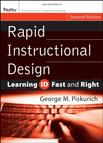急速规程设计
出版时间:2006-12 出版社:John Wiley & Sons Inc 作者:Piskurich, George M. 页数:484
内容概要
This is the second edition of the best-selling book that shows how to get instructional design done fast and get it done right! If you need a basic understanding of what instructional design is and a hands-on, to-the-point method of ensuring that the training and performance interventions you put into place meet the needs of your staff and your organization, this book is for you. It offers a no-nonsense walk through all the steps in the instructional design process and each step is explained in language that is conversational and easy to understand. This new edition addresses such topics as learning analysis, return on investment, and designing asynchronous and synchronous e-learning, as well as a wealth of illustrative examples of storyboards and professional commentary and case studies from professionals in the field. 作者简介: George M. Piskurich is an organizational learning and performance consultant specializing in e-learning interventions, performance analysis, and telecommuting. He is the author of numerous books including Getting the Most from Online Learning, Self-Directed Learning: A Practical Guide to Design and Preparing Learners for e-Learning all published by Pfeiffer.
书籍目录
Preface to the Second Edition Introduction Chapter 1: What Is This Instructional Design Stuff Anyway? Why Instructional Design? What Is Instructional Design? A Few Definitions Advantages of Instructional Design Disadvantages of Instructional Design Chapter 2: Before You Do Anything: Pre-Instructional Design Activities Organizational Needs Performance Assessment Assessing Training Needs Choosing Needs to Address The Needs Analysis Report Quick and Dirty Cost-Benefit Analysis Chapter 3: Do You Know What You Need to Do? Analysis Data-Collection Methods Why Analyze? Types of Analysis Computer-Aided Analysis Chapter 4: How to Do It: Design Make the Right Decision Now Delivery Decision (Training Setting) Objectives Design Documents / 130 Course Descriptions / 145 Gathering Content Adding Structure: The Instructional Plan Trainee Evaluation (Test Questions and Tests) Hints for Designing in Various Formats Chapter 5: Doing It Right: Development End Products of Development The Lesson Plan As an End Product Scripts and Storyboards Participants’ Packages and Other Print Materials Other Media Hints for Developing Material Chapter 6: Getting It Where It Does the Most Good: Implementation Beta Tests and Pilots Reviews Revisited Common Implementation Issues Hints for Implementation Chapter 7: Did It Do Any Good? Evaluation Why Evaluation? The Key to Good Evaluation Types of Evaluation Evaluation of Self-Instructional Programs Revisions: What to Do with What You’ve Learned Hints for Evaluating Chapter 8: Doing It Faster: More Rapid Design Shortcuts Software for Instructional Design Analysis Software Test Development Software Miscellaneous Software Rapid Prototyping Learning Objects and Granular Training Public Courses Off-the-Shelf Programs Technology Vendors Performance Support–Based “Training” Problem-Based Learning (PBL) Training Management Systems Miscellaneous Chapter 9: Asynchronous E-Learning Design Definitions Creating and Implementing an E-Learning System Determining a Comprehensive E-Learning Strategy Designing and Developing Good Programs Learning Management Systems and Learning Content Management Systems Preparing the Organization Globally for E-Learning Planning for a Smooth, Successful Implementation Creating an Effective Monitoring and Evaluation Plan Asynchronous E-Learning Design and Development Analysis Material Development Learner Evaluation Learner Interfaces Beta Tests and Pilots Software Repurposing Evaluating Asynchronous E-Learning Programs Summary Chapter 10: Synchronous E-Learning Design Advantages Disadvantages and Misconceptions Design Considerations for Synchronous E-Learning Mini-Interactions Repurposing and Redesigning of Synchronous E-Learning Programs Other Synchronous Activities More Detailed Facilitator Guides Learner Guide General Technology Considerations Media Designing Continuing Interactions Audience Analysis Implementation Online Learning: A Special Type of E-Learning What the Learners Say Glossary Suggested Readings Other Resources About the Author Instructor Guide for Rapid Instructional Design Index
图书封面
评论、评分、阅读与下载
用户评论 (总计0条)
推荐图书
- 创新报酬:将知识产权传化为股东价值的人们(英文原版进口)
- 固定收入有价证券的投资
- 伊斯兰金融
- 一切为了服务
- 热门交易揭秘(英文原版进口)
- 内在的品牌
- 品牌裸置
- 交易大突破
- 一年将产品推向市场
- 预算基础及其它
- 客户战略
- BUILDING CROSS-CULTURAL COMPETENCE - HOW TO CREATE WEALTH FROM CONFLICTING VALUES(英文原版进口)
- 商业智能化能力提升中心
- 商业领袖BUSINESS LEADERSHIP
- 企业与全球贫困
- 如同管弦乐编曲的领导
- CFO透视
- 首席财务官悟性
- 销售大赛
- Cisco Net Impact: Competitive Advantage from Internet Innovators in Asia Pacific and Japan (精装)
- 债务抵押义务
- 公司财务
- 企业学习
- Covered Calls - 财富选择 + DVD
- 价值黑洞
相关图书
- 再创亚洲
- 财产出租导论 第2版(英文原版进口)
- 结果法则!
- 反思! 爱德华在澳大利亚 RETHINK
- 再接,再雇
- 风险管理(英文原版进口)
- 风险量化
- 罗宾逊营销
- Flash 8 速成教程 FLASH 8 ACCELERATED
- 聚焦如同激光束:最应做的事之10种方法(英文原版进口)
- 7年中从0到260+财产 FROM 0 TO 260+ PROPERTIES IN 7 YEARS
- 从企业家到信息企业家
- 增益控制
- 组织考察与行动
- 公司管理
- 信息安全手册(3卷集)
- 大人物销售智慧:销售福利战略、说服的秘密与成功常识(英文原版进口)
- 一桥
- 热点商品
- 如何应对难对付的客户
- 如何于商业房地产中赚钱
- 我可学至500
- 创新或死亡
- 通过价值观的领导
- Maya 7 导论
